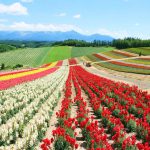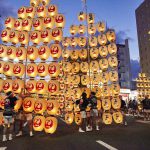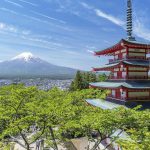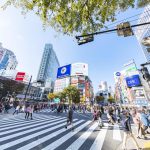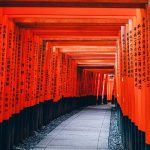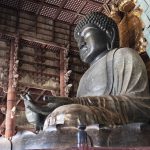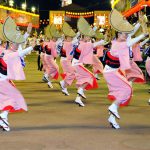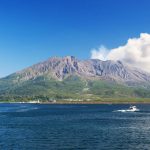Okinawa
Okinawa is located in the southwestern part of Japan, about 1,000 km from east to west, and 400 km from north to south. It consists of 160 islands of various sizes, including the Okinawa Islands, Sakishima Islands (Miyako, Yaeyama, and Senkaku Islands), and Daito Islands.
In the past, Okinawa prospered through trade with Southeast Asia and China as the Ryukyu Kingdom, and became Okinawa Prefecture in 1879. During the Pacific War, Okinawa was the site of a fierce battle that lasted about three months between the Japanese and U.S. military forces, and many of the islanders lost their lives. After the war, Okinawa was occupied by the United States, and later returned to Japan in 1972.
Okinawa has its own unique culture, customs, and religion. The music of Okinawa is unique in its scales, singing and instruments. The sanshin, a three-stringed banjo-like instrument with a snakeskin covered body, is an instrument that is essential to traditional Okinawan music, such as Ryukyu dance songs, folk songs, and pop music. If you visit Okinawa, be sure to visit a minyo izakaya (Japanese pub) or minyo bar where you can enjoy live Okinawan folk songs. You can experience singing and dancing with the Okinawan people, while listening to the sounds of finger whistling, sanba (Ryukyu castanets), and sanshin. Eisa is a traditional art form performed during the Obon Festival in August or September. It is a moving experience to see young people beating drums, and dancing to the music to welcome the spirits of the ancestors who return to this world during Obon.
With a warm subtropical climate throughout the year, Okinawa is abundant with agricultural products such as pineapples and mangoes. Coral reefs and mangroves grow naturally, and unique island creatures such as the Iriomote wild cat, Okinawa rail, and coconut crab are also found in Okinawa. The beauty of the ocean is extraordinary, and you can see manta rays and marine mammals known as dugongs. Okinawa is truly a treasure trove of nature.
Naha
Naha, the capital of Okinawa Prefecture, is home to Shuri Castle, the political, diplomatic and cultural center of the Ryukyu Kingdom era. The magnificent castle, with its bright vermillion-painted main hall and Shureimon Gate is registered as a World Heritage Site. In 2019, a fire destroyed the main hall and other buildings, as well as numerous artifacts, and efforts are now underway to rebuild it.
Kokusai-dori (International Street) is the main street of Naha, lined with souvenir shops and restaurants. You can buy a variety of food products, such as colorful fish, pig’s feet, large chunks of pork, and island vegetables like Goya (bitter melon) at Makishi Public Market, located close to Kokusai-dori. There is a cafeteria on the 2nd floor, where you can try local Okinawan dishes and sweets, including Goya Chanpuru (stir fry) and Soki Soba (pork rib noodles). It is also a place where you can enjoy the food culture of Okinawa by cooking the food you buy at the market. (Makishi Public Market is currently undergoing construction of a new building, and is temporarily operating at a nearby location until March 31, 2022. The new market is scheduled to begin operation on April 1, 2022.)
The Peace Memorial Park was built on the site of a battlefield in the southern part of the main island of Okinawa. The park includes Mabuni Hill, where the final events of the Battle of Okinawa occurred; Okinawa Peace Hall; National Peace Mausoleum; Peace Hill Monument; and the Okinawa Prefectural Peace Memorial Museum, that commemorates the tragedy of the Battle of Okinawa. The Himeyuri Monument and the Himeyuri Peace Museum, located about four km west of the Peace Memorial Park, are also places where you may offer prayers for peace.
Churaumi Aquarium
Okinawa Churaumi Aquarium is one of the largest aquariums in the world, that sets the ocean of Okinawa right before your eyes. You will be overwhelmed by the sheer scale of the aquarium, and awestruck by the ocean’s splendor.
Sefa Utaki
Sefa Utaki, located in Nanjo City, east of Naha, is the most sacred place in the Ryukyu Kingdom. It is said to have been created by Amamikiyo, the founding god of the Ryukyu Kingdom. Many national rituals have been held there, and it includes six sacred areas called ibi. One of them, the sanctuary of Sankori, is located through a triangular space created by huge supporting rocks. You can learn more about Sefa Utaki by touring the premises with a guide. This mysterious sanctuary surrounded by the splendid nature of trees, rocks and stones, is an important place for the people of Okinawa; for this reason, visitors are requested to observe proper etiquette at all times.
Kerama Islands
Included in the Okinawa Islands, the Kerama Islands consist of about 20 islands of various sizes such as Tokashiki Island and Zamami Island. Known as one of the best scuba diving spots in the world for its crystal transparency, it is referred to as “Kerama Blue.” Aharen Beach on Tokashiki Island is known as a beautiful stretch of white sandy shores.
Iriomote Island
Iriomote Island is the second largest island in Okinawa Prefecture, after Okinawa Island, and can be accessed from Ishigaki Island by high-speed boat or ferry. Almost 90% of Iriomote Island is covered with subtropical virgin jungle, and the entire island is designated as Iriomote Ishigaki National Park. Nearly 40 rivers flow through the island, and the largest mangrove forests in Japan spreading into the Nakama River are particularly magnificent. Many precious animals and insects inhabit this untouched natural environment, such as the Iriomote wild cat, crested serpent eagle, yellow-margined box turtle, Sakishima habu (venomous snake), Iriomote horseshoe bats, and Iriomote fireflies. You can also enjoy canoeing, stand-up paddle boarding, and snorkeling. The experience of crossing over the ocean to Yubu Island, located east of Iriomote Island, on a buffalo-drawn cart will make a great memory.
Taketomi Island
Taketomi Island, located 10 minutes by high-speed boat from Ishigaki Island, is a small island with a circumference of about 9 km. It is an island where the original Okinawan landscape remains, with white sand roads and houses with red tile roofs. Time passes slowly on the island, and an occasional folk song can be heard drifting through the air, stirring up a sense of journey. You can take a tour of the island by water buffalo cart or rent a bicycle. There are several beaches on Taketomi Island. We recommend Kondoi Beach with its white sands, and Aiyaru Beach with its clear emerald green waters. Also, several guest houses are available for overnight stays, so be sure to make arrangements for a special experience, gazing at the starry skies.


